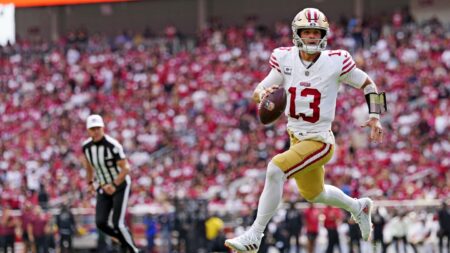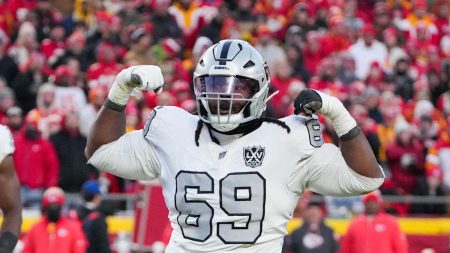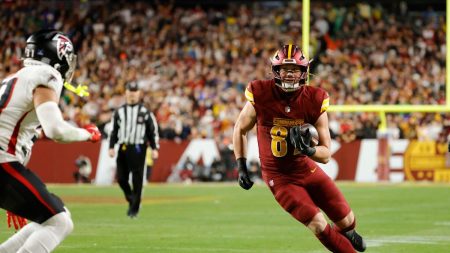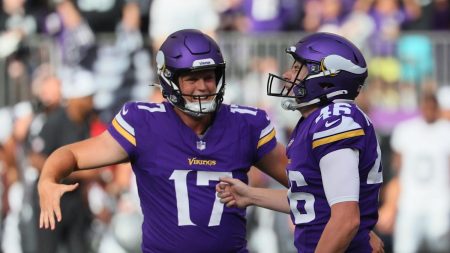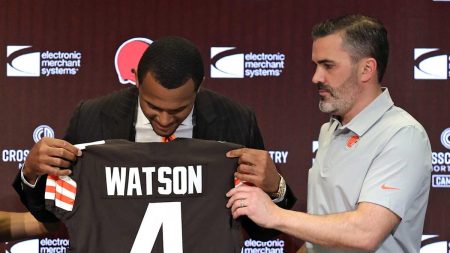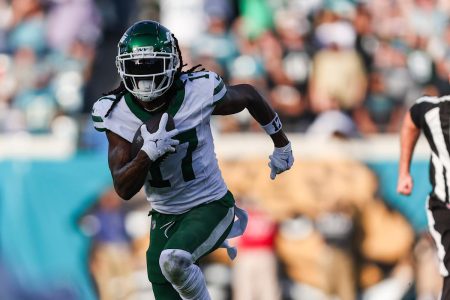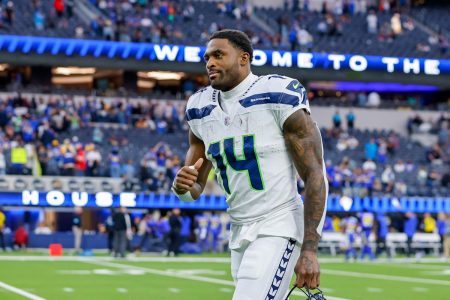The Dam Breaks: The Unrelenting Pressure of Super Bowl LIX
Super Bowl LIX felt like a dam breaking, with the pressure mounting from both sides but ultimately overwhelming the Kansas City Chiefs. The cracks, both visible and hidden, widened under the relentless assault. The weaknesses became more pronounced, until the gaps turned into chasms, and everything was swept away by the now-freed water. The Philadelphia Eagles, often embodied by the underdog spirit of Rocky Balboa, played more like Ivan Drago in this championship game, delivering a crushing and decisive victory. The pressure from the Eagles’ defensive line and the constant threats posed by quarterback Jalen Hurts were too much for the defending champs to handle. Patrick Mahomes, the Chiefs’ quarterback, found himself under an unprecedented level of pressure, with a higher pressure rate than his completion percentage in the first half alone.
A Complete Defensive Masterpiece
Coordinator Vic Fangio and the Eagles’ defense orchestrated a performance for the ages. Every player made their mark, with some delivering the best games of their careers. Josh Sweat recorded an impressive six pressures, more than the combined efforts of Kansas City stars George Karlaftis and Chris Jones. Six different defenders recorded multiple pressures, and the onslaught came from every direction. The left side of the Chiefs’ offensive line, with Joe Thuney playing out of position at left tackle and Mike Caliendo struggling at left guard, was particularly weak. Thuney allowed six pressures, Caliendo seven, and right guard Trey Smith had several rough moments both in pass protection and the run game. Even tight end Travis Kelce, usually a reliable and dominant force, was unable to hold up, contributing to pressures on back-to-back plays. Rookie Jalyx Hunt and seventh-round pick Moro Ojomo also shone, with Hunt recording multiple pressures and Ojomo adding four pressures and a tackle for loss on limited snaps. The Eagles’ defensive backs aggressively played routes and tackled well, squeezing every bit of space and making life difficult for Mahomes and his receivers.
Disguised Defenses and Explosive Plays
The Eagles’ defensive strategy was multifaceted and executed to perfection. They primarily played zone coverage, but on the first third down of the game, Fangio threw a change-up with Cover 1 Robber, a man coverage scheme with one safety deep and another roaming over the middle to "rob" routes or read the quarterback’s eyes. This play was a harbinger of things to come. The pre-snap look was deceptive, with safety Reed Blankenship initially splitting out over the running back before working his way back deep. This disguised the coverage just enough to confuse Mahomes. When the play unfolded, cornerback Isaiah Rodgers did an excellent job staying with Hollywood Brown, forcing Mahomes to scramble and throw an incomplete pass into traffic. This level of coordination and awareness from the entire defensive unit, including the sixth defensive back, was a key factor in neutralizing the Chiefs’ aggressive offense.
Eagles Neutralize KC’s Aggressive Defense
The Eagles’ offense was equally dominant, despite the Chiefs’ aggressive defensive strategy. The Chiefs focused heavily on the run game, limiting Saquon Barkley to only four successful runs and zero explosive rushes. This was only the fifth time a team with a sub-20% rushing success rate won a playoff game since 2012. However, the Eagles’ passing game more than made up for the lack of running success. Two plays, in particular, stood out. The first was a 27-yard completion to Jahan Dotson on second-and-11, setting up the Eagles’ first score. This play showcased the Eagles’ pre-snap recognition and post-snap execution, with Hurts making quick decisions and the offensive line providing excellent protection against a blitz. The second play was a third-down scramble by Hurts, where he chose to move between the tackles rather than drifting outside. This decisive action allowed him to extend the play and gain 16 yards, keeping the chains moving. The Chiefs’ "Odd Mirror" defensive front, designed to bait Hurts into bailing out of the pocket, failed to contain him, and he decisively stepped up and made the play. Hurts’ quick decision-making and the ability to break down the pocket from within kept the Chiefs on their toes and unable to consistently mount a defensive stand.
Chiefs’ Self-Inflicted Wounds
The Chiefs’ struggles were exacerbated by self-inflicted wounds. Penalties in high-leverage situations gifted the Eagles first downs and extended drives. Nick Bolton’s late hit on Barkley turned a third-and-26 into a first down, and Charles Omenihu’s offsides penalty negated a third-down sack by Karlaftis. Trent McDuffie’s unnecessary roughness penalty on third-and-5 was particularly devastating, leading to the Eagles’ first touchdown. McDuffie’s mistake came on a crucial play where the Chiefs expected to gain an advantage. A.J. Brown got McDuffie off balance, and he was slightly out of position, failing to intercept a key pass and instead drawing a flag. The Eagles’ superior starting field position, thanks in part to immaculate special teams play, also played a significant role. Philadelphia’s average starting field position was their own 42, while the Chiefs’ was their 24. Chiefs punter Matt Araiza struggled, with his boom-only style and lack of finesse resulting in negative expected points added (EPA) on four of his six punts. His inability to pin the Eagles deep or flip field position only added to the Chiefs’ mounting problems.
The Eagles’ Offensive Resilience
Despite being targeted heavily by the Chiefs’ defense, the Eagles’ offense remained resilient and efficient. Jalen Hurts demonstrated both his passing and running prowess, making quick and decisive plays that kept the Chiefs guessing. The 27-yard completion to Jahan Dotson on second-and-11 was a prime example of the Eagles’ ability to neutralize the Chiefs’ blitzes. The offensive line, often facing four blitzers and non-traditional pass rushers, consistently provided Hurts with a clean pocket. Hurts’ scramble between the tackles on third-and-5, where he avoided the "Odd Mirror" front and extended the play, was a testament to his decision-making and mobility. The Chiefs’ defensive strategy, which aimed to pressure Hurts and force him into mistakes, was outmatched by the Eagles’ well-coordinated and aggressive approach. Even when the Chiefs did make plays, such as the early interception, the Eagles’ momentum and pressure from both sides kept the game firmly in their control.
The Final Act: A Dominant Victory
After the Eagles’ opening drive stalled, they essentially dominated the rest of the game. The combination of their relentless pressure on Mahomes, the precise execution of their offensive plays, and the Chiefs’ numerous self-inflicted errors created an overwhelming advantage. The Eagles’ defense consistently disrupted Mahomes’ rhythm, and their offensive weapons, led by Hurts, delivered time and time again. The Chiefs, despite their best efforts, could not match the intensity and precision of the Eagles. The game turned into a one-sided affair, with Philadelphia’s defense and offense working in harmony to dismantle the defending champions. The final score was a reflection of the sheer dominance and the unrelenting pressure that the Eagles brought to bear, marking a memorable and well-deserved Super Bowl victory.


